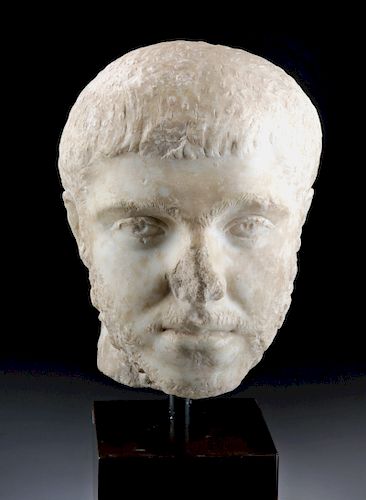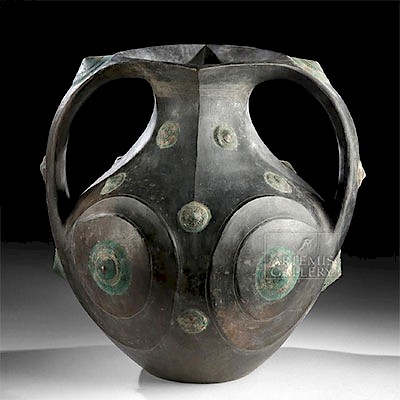Published & Exhibited Roman Marble Head of Bearded Male
Lot 46c
About Seller
Artemis Fine Arts
686 S Taylor Ave, Ste 106
Louisville, CO 80027
United States
Selling antiquities, ancient and ethnographic art online since 1993, Artemis Gallery specializes in Classical Antiquities (Egyptian, Greek, Roman, Near Eastern), Asian, Pre-Columbian, African / Tribal / Oceanographic art. Our extensive inventory includes pottery, stone, metal, wood, glass and textil...Read more
Estimate:
$60,000 - $80,000
Absentee vs Live bid
Two ways to bid:
- Leave a max absentee bid and the platform will bid on your behalf up to your maximum bid during the live auction.
- Bid live during the auction and your bids will be submitted real-time to the auctioneer.
Bid Increments
| Price | Bid Increment |
|---|---|
| $0 | $25 |
| $300 | $50 |
| $1,000 | $100 |
| $2,000 | $250 |
| $5,000 | $500 |
| $10,000 | $1,000 |
| $20,000 | $2,500 |
| $50,000 | $5,000 |
| $100,000 | $10,000 |
| $200,000 | $20,000 |
About Auction
By Artemis Fine Arts
Jul 11, 2019
Set Reminder
2019-07-11 10:00:00
2019-07-11 10:00:00
America/New_York
Bidsquare
Bidsquare : Ancient / Ethnographic / Americana
https://www.bidsquare.com/auctions/artemis-gallery/ancient-ethnographic-americana-4246
Discover ancient art from Egypt, Greece, Italy, and the Near East, as well as Asian, Pre-Columbian, Tribal, Fossils and Fine Art. Also featuring a wonderful collection from a prominent New York estate whose owners reside in the Van Wyck family's historic Lloyd Harbor waterfront home. Artemis Fine Arts info@artemisgallery.com
Discover ancient art from Egypt, Greece, Italy, and the Near East, as well as Asian, Pre-Columbian, Tribal, Fossils and Fine Art. Also featuring a wonderful collection from a prominent New York estate whose owners reside in the Van Wyck family's historic Lloyd Harbor waterfront home. Artemis Fine Arts info@artemisgallery.com
- Lot Description
Roman, Imperial Period, Late Severan, ca. mid-3rd century CE. Finely carved from white marble, a more than life-sized head of a middle-aged bearded male with an expressive countenance, perhaps not imperial, however, a powerful portrait of an important individual given the scale and fine delineation, created during the era of Emperor Alexander Severus. The sculptor of this piece truly knew how to bring marble to life with veristic features: heavy-lidded almond-shaped eyes with drilled pupils, feathery brows with incised individual hairs, an aquiline nose (with losses as is oftentimes the case for Roman busts), full lips with delineated philtrum and mustache, nasolabial folds, a neatly manicured curly beard, and naturalistic ears - this handsome visage crowned by a close-cropped, forward combed, wavy coiffure. Size: 8.5" L x 8" W x 11.5" H (21.6 cm x 20.3 cm x 29.2 cm); 17.625" H (44.8 cm) on included custom stand.
In very early Rome, men wore their beards uncut. It was not until 300 BCE, that Roman men shaved their beards as a rule according to Pliny (VII. 59). Pliny notes that P. Ticinius Maenas brought over a barber from Sicily at this time, and from then on, shaving became regular habit. During the later Republican Period, some men partially shaved and trimmed their beards. Interestingly, when mourning, men would allow their beards to grow, but in general, beards during this time were thought to be a mark of the lower classes and slovenliness. In addition, the first time a male shaved was noted as a milestone - a signature of manhood. The Emperor Hadrian (reigned 117-138 CE), however, revived the beard. According to Plutarch, he wore a beard to hide scars on his face. Thereafter, beards were favored by emperors until the time of Constantine the Great (reigned 306-337 CE).
Published in "The Muse's Song: Selections of Ancient Art." Fortuna Fine Arts, Ltd., 2008, fig. 31. Exhibited by Cahn AG, Switzerland, 2016-2019 including Tefaaf Maastricht, Netherlands 2017; Frieze Masters, London 2017; La Biennale, Paris 2018.
Cf a similar head in Jale Inan & Elisabeth Rosenbaum, "Roman and Early Byzantine Portrait Sculptures in Asia Minor" (London, 1966), cat.no. 181, pp. 143-144, pl. 106.1-2.; a fragmentary portrait identified as Alexander Severus in the Capitoline Museum, Magazine inv. 1431, published in Klaus Pittschen & Paul Zanker, "Katalog der Romischen Portraits in des Capitolishen Museum (Mainz, 1983), vol. 1, cat.no. 102, pl. 125; the head of a young man in the Museo Nazionale Romano, Rome, inv.no. 71938, published in Bianca Maria Felletti Maj. "Museo Nazionale Romano I Rittratti" (Rome 1953), cat.no. 299, p. 150.
Provenance: private East Coast, USA collection; ex-Gallery Serodine 1980's; Published in "The Muse's Song: Selections of Ancient Art." Fortuna Fine Arts, Ltd., 2008, fig. 31. Exhibited by Cahn AG, Switzerland, 2016-2019 including Tefaaf Maastricht, Netherlands 2017; Frieze Masters, London 2017; La Biennale, Paris 2018.
All items legal to buy/sell under U.S. Statute covering cultural patrimony Code 2600, CHAPTER 14, and are guaranteed to be as described or your money back.
A Certificate of Authenticity will accompany all winning bids.
We ship worldwide and handle all shipping in-house for your convenience.
#147189Expected surface wear commensurate with age and some losses to peripheries of nose, ears, brow line, bangs, neck line, and other high-pointed areas as shown. Deposits grace the surface.Condition
- Shipping Info
-
All shipping is handled in-house for your convenience. Your invoice from Artemis Gallery will include shipping calculation instructions. If in doubt, please inquire BEFORE bidding for estimated shipping costs for individual items.
-
- Buyer's Premium



 EUR
EUR CAD
CAD AUD
AUD GBP
GBP MXN
MXN HKD
HKD CNY
CNY MYR
MYR SEK
SEK SGD
SGD CHF
CHF THB
THB














